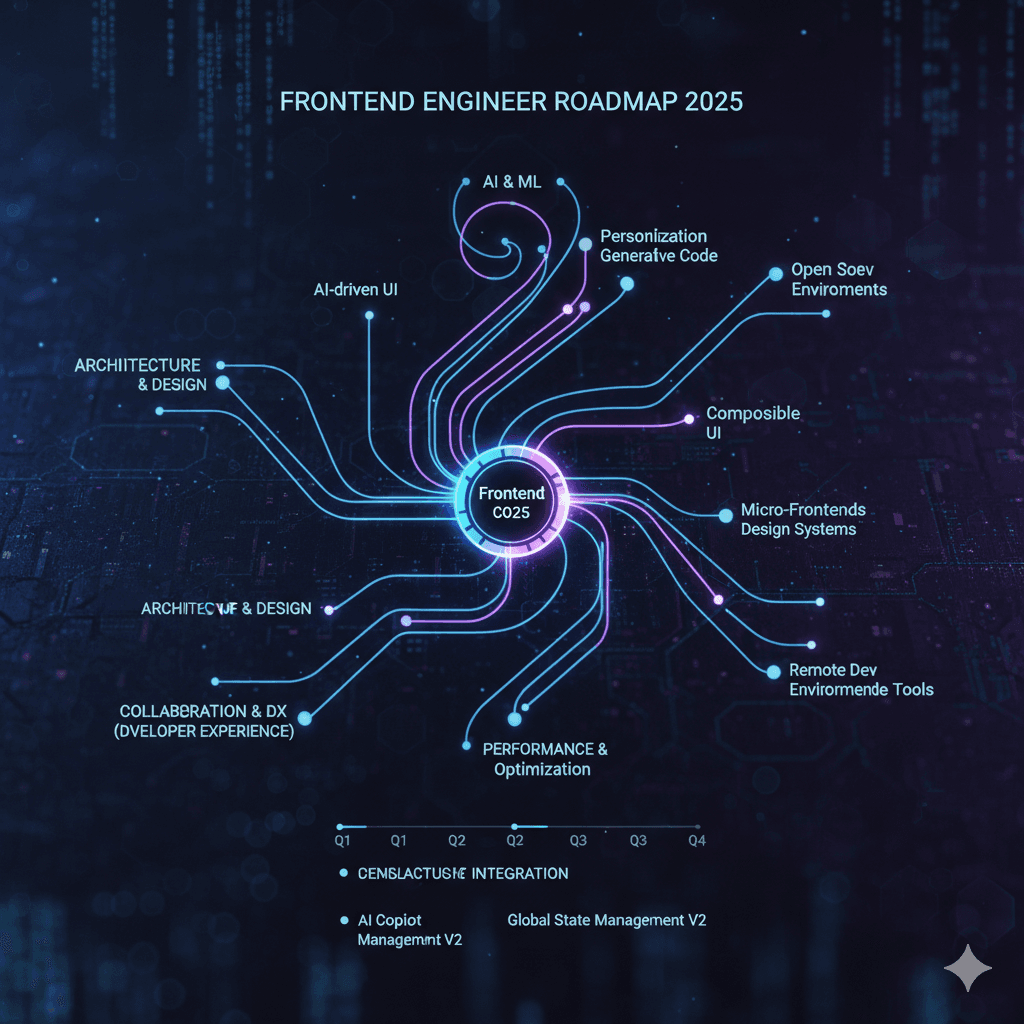
How to Stay Ahead in 2025 as a Frontend Engineer
By Ghazi Khan | Oct 12, 2025 - 5 min read
The frontend world is moving fast. What seemed bleeding-edge last year can feel obsolete today.
If you want to stay ahead in 2025, you need more than just knowing a framework — you need foresight, adaptability, and a growth mindset.
Here’s your modern playbook: skills, tools, strategies, and habits to keep you relevant, valuable, and ahead of the curve.
1. Lock Down the Foundations — Make Them Rock Solid
Before chasing the shiny stuff, your base must be unshakeable.
- HTML, CSS, JavaScript mastery — semantic HTML, grids, flexbox, modern ES features.
- Accessibility & SEO — not optional. WCAG compliance, alt tags, proper ARIA, well-formed metadata.
- Clean coding habits — disciplined architecture, modular code, consistent conventions. You’ll thank yourself in six months.
These basics are your anchor — no trend or new tool outruns solid fundamentals.
2. Pick a Strong Stack — But Don’t Spread Yourself Thin
In 2025, trying to “know everything” is a fast route to burnout.
- Choose one or two frontend frameworks (React, Vue, Svelte, Qwik, etc.) and go deep.
- Learn the surrounding ecosystem: routing, state management, data fetching, SSR/SSG strategies.
- Understand architecture patterns: component-driven design, micro-frontends, module federation. (Bonus: read about bundler-independent module federation research)
You don’t have to master every library — just be outstanding in your chosen stack.
3. Embrace AI & Automation as Your Sidekick, Not Threat
AI is no longer a gimmick — it’s becoming part of your daily workflow. Use it wisely.
- AI coding assistants (Copilot, ChatGPT, others) for boilerplate, suggestions, refactors.
- AI design & prototyping tools — Figma + AI modes to accelerate UI mockups.
- Automated testing and QA with AI-driven tools to catch accessibility or style regressions.
- But always audit what the AI gives you — it’s a helper, not a replacement.
Integrating these tools into your workflow gives you scale and speed, but your human judgment is still the differentiator.
4. Performance & Resource Efficiency Become Your Identity
In 2025, slowness is your enemy.
- Ship less JavaScript to the browser — lazy load, code split, tree shake aggressively.
- Use server-side rendering, streaming, islands or partial hydration approaches.
- Explore WebAssembly for performance-critical parts.
- Apply sustainable development practices: minimize resource usage, prune dead code, reduce energy consumption.
Performance isn’t a bonus — it’s table stakes.
5. Architecture, Scaling & Edge Thinking
To stay relevant, you’ll need to understand how to build apps that don’t collapse under complexity.
- Micro-frontends & module federation — break big apps into team-scalable pieces.
- Edge-first approaches — moving logic closer to the user (CDNs, edge functions).
- Server & client boundary design — you’ll need to decide what runs where, how to stitch it together.
- Bundler-independent techniques — removing coupling between architecture and build tools.
Your value will increasingly come from making architectural decisions, not just writing UI.
6. Expand Into AI, ML & Browser Intelligence
Frontend engineers in 2025 are part-ML engineers, too.
- TensorFlow.js, ml5.js, ONNX.js — bring model inference to the browser.
- Build smart UIs — dynamic personalization, predictive components, context-aware behavior.
- Experiment with LLMs or local AI agents that run offline in-browser or on the edge.
- Dive into bidirectional human-AI alignment — how to safely combine user intent + AI models. (See “DesignRepair” research)
Don’t just use AI — build the next-gen interactions with it.
7. Soft Skills: The Multiplier You Can’t Ignore
Technical skills get you in the door. Soft skills make you indispensable.
- Communication & collaboration — clearly explain tradeoffs, defects, and architecture to non-tech stakeholders.
- Curiosity and learning habits — carve time for reading, experimenting, side projects.
- Documentation & sharing — blog, open-source, teach — it reinforces your thinking and raises your profile.
- Adaptability — frameworks change, paradigms shift. The ones who last are the ones who evolve.
Nobody outlearns the field — but you can out-adapt it.
Conclusion
Staying ahead as a frontend engineer in 2025 is no joke — it’s a continuous race.
But you don’t need to sprint everywhere. Focus on foundations + specialization + curiosity. Leverage AI as a wingman, not a crutch.
Over time, your power comes not from knowing everything, but from knowing how to learn fast, make smart architectural choices, and build UIs that feel like magic.
Here’s your challenge:
Pick one area from above — AI tooling, edge architecture, ML UI — jump in full and build something.
That learning is what becomes your competitive edge next year.
🔗 Related Reads
Stay informed about framework shifts by reading React Goes Independent — What the New React Foundation Means for Developers.
Learn what’s new in the Svelte ecosystem in Deep Dive: SvelteKit 2.43 Async SSR & Remote Functions Explained.
Then see how all major frameworks stack up in Frontend Framework Wars 2025 — React Still Reigns, But Svelte and Qwik Are Coming for the Crown.
Advertisement
Ready to practice?
Test your skills with our interactive UI challenges and build your portfolio.
Start Coding Challenge